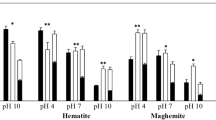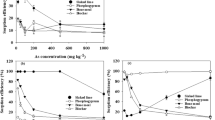Abstract
Oxide-rich materials, such as “red mud,” an aluminum-mining by-product, are good (ad)sorbents for soil pollutants. This study evaluated sorption reactions of selected cations/anions on aluminum-mining by-product, proposing the calculation of a new distribution constant (i.e., distribution constant at half of the maximum adsorption capacity, Kd(MAC/2)) to assess aluminum-mining by-product sorption efficiency. Adsorption was performed with increasing doses of zinc, copper, cadmium, lead, arsenic, and phosphorus, followed by subsequent desorption (pH 5.5). Data fitted well to both Langmuir and Freundlich equations. The maximum adsorption capacity estimated by the Langmuir equation and the relative adsorption capacity parameter of the Freundlich equation followed the ascending order cadmium < zinc < copper < lead < arsenic < phosphorus, whereas the distribution constant at half of the maximum adsorption capacity increased as follows: cadmium < zinc < copper < arsenic < lead < phosphorus. Anionic (ad)sorbates (i.e., arsenic and phosphorus) showed higher affinity for aluminum-mining by-product than cationic ones. Among the studied cations, lead and copper were much more adsorbed by aluminum-mining by-product than zinc and cadmium. High adsorption and low desorption occurred mostly for elements known to form inner-sphere complexes, such as phosphorus and lead. Desorption from aluminum-mining by-product was very low for all sorbates, except cadmium. The aluminum-mining by-product, a low-cost by-product, proved to be an adequate adsorbent for pollutants removal. Moreover, the distribution constant at half of the maximum adsorption capacity could be used as an alternative parameter for sorption studies with aluminum-mining by-product and conceivably other sorbents.





Similar content being viewed by others
References
Ahmed MJK, Ahmaruzzaman M (2016) A review on potential usage of industrial waste materials for binding heavy metal ions from aqueous solution. J Water Process Eng 10:39–47. https://doi.org/10.1016/j.jwpe.2016.01.014
Altundogan HS, Altundogan S, Tümen F, Memnune B (2000) Arsenic removal from aqueous solutions by adsorption on red mud. Waste Manag 20:761–767. https://doi.org/10.1016/S0956-053X(00)00031-3
Apak R, Guçlu K, Turgut MH (1998a) Modeling of copper(II), cadmium(II), and lead(II) adsorptions on red mud. J Colloid Interface Sci 203:122–130. https://doi.org/10.1006/jcis.1998.5457
Apak R, Tutem E, Hugul M, Hizal J (1998b) Heavy metal cation retention by unconventional sorbents (red mud and fly ashes). Water Res 32:430–440. https://doi.org/10.1016/S0043-1354(97)00204-2
Atkins PW, Paula J, Keeler J (2018) Physical chemistry, 11th edn. Oxford University Press, Oxford
Barrow NJ (2008) The description of sorption curves. Eur J Soil Sci 59:900–910. https://doi.org/10.1111/j.1365-2389.2008.01041.x
Basílio MS, Friese K, Lena JC, Naline Júnior HA, Roeser HMP (2005) Adsorção de As, Cu, Pb e Cr na avaliação da capacidade de fixação de metais por resíduo de mineradoras de ferro. Quim Nova 28:822–828. https://doi.org/10.1590/S0100-40422005000500018
Bhatnagar A, Vilar VJP, Botelho CMS, Boaventura RAR (2011) A review of the use of red mud as adsorbent for the removal of toxic pollutants from water and wastewater. Environ Technol 32:231–249. https://doi.org/10.1080/09593330.2011.560615
Brunori C, Cremisini C, Massanisso P, Pinto V, Torricelli L (2005) Reuse of a treated red mud bauxite waste: studies on environmental compatibility. J Hazard Mater 117:55–63. https://doi.org/10.1016/j.jhazmat.2004.09.010
Carolin CF, Kumar PS, Saravanan A, Joshiba GJ, Naushad M (2017) Efficient techniques for the removal of toxic heavy metals from aquatic environmental: a review. J Environ Chem Eng 5:2782–2799. https://doi.org/10.1016/j.jece.2017.05.029
Castaldi P, Santona L, Enzo S, Melis P (2008) Sorption processes and XRD analysis of a natural zeolite exchanged with Pb2+, Cd2+ and Zn2+ cations. J Hazard Mater 156:428–434. https://doi.org/10.1016/j.jhazmat.2007.12.040
Cengeloglu Y, Tor A, Arslan G, Ersoz M, Gezgin S (2007) Removal of boron from aqueous solution by using neutralized red mud. J Hazard Mater 142:412–417. https://doi.org/10.1016/j.jhazmat.2006.08.037
Cengeloglu Y, Tor A, Ersoz M, Arslan G (2006) Removal of nitrate from aqueous solution by using red mud. Sep Purif Technol 51:374–378. https://doi.org/10.1016/j.seppur.2006.02.020
Chang-Jun L, Yan-Zhong L, Zhao-Kun L, Zhao-Yang C, Zhong-Guo Z, Zhi-Ping J (2007) Adsorption removal phosphate from aqueous solution by active red mud. J Environ Sci 19:1166–1170. https://doi.org/10.1016/S1001-0742(07)60190-9
Costa ETS, Guilherme LRG, Curi N, Lopes G, Visioli EL, Oliveira LCA (2009) Caracterização de subproduto da indústria de alumínio e seu uso na retenção de cádmio e chumbo em sistemas monoelementares. Quim Nova 32:868–874. https://doi.org/10.1590/S0100-40422009000400008
Costa ETS, Guilherme LRG, Curi N, Lopes G (2012a) Mono- and multielement sorption of trace metals on oxidic industrial by-products. Water Air Soil Pollut 223:1661–1670. https://doi.org/10.1007/s11270-011-0973-8
Costa ETS, Guilherme LRG, Lopes G, Lima JM, Curi N (2012b) Competitive sorption of arsenate and phosphate on aluminum mining by-product. Water Air Soil Pollut 223:5433–5444. https://doi.org/10.1007/s11270-012-1291-5
Costa ETS, Guilherme LRG, Lopes G, Marques JJ, Curi N (2014) Effect of equilibrium solution ionic strength on the adsorption of Zn, Cu, Cd, Pb, As, and P on aluminum mining by-product. Water Air Soil Pollut 225:1894–1905. https://doi.org/10.1007/s11270-014-1894-0
Du Y, Dai M, Cao J, Peng C (2019) Fabrication of a low-cost adsorbent supported zero-valent iron by using red mud for removing Pb(II) and Cr(VI) from aqueous solutions. RSC Adv 9:33486–33496. https://doi.org/10.1039/C9RA06978J
Geelhoed JS, Hiemstra T, Riemsdijk WHV (1997) Phosphate and sulfate adsorption on goethite: single anion and competitive adsorption. Geochim Cosmochim Acta 61:2389–2396. https://doi.org/10.1016/S0016-7037(97)00096-3
Genç H, Tjell JC, McConchie D, Schuiling O (2003) Adsorption of arsenate from water using neutralized red mud. J Colloid Interface Sci 264:327–334. https://doi.org/10.1016/S0021-9797(03)00447-8
Genç-Fuhrman H, Bregnhoj H, McConchie D (2005) Arsenate removal from water using sand-red mud columns. Water Res 39:2944–2954. https://doi.org/10.1016/j.watres.2005.04.050
Guan XH, Wang J, Chusuei CC (2008) Removal of arsenic from water using granular ferric hydroxide: macroscopic and microscopic studies. J Hazard Mater 156:178–185. https://doi.org/10.1016/j.jhazmat.2007.12.012
Guo H, Stüben D, Berner Z (2007) Adsorption of arsenic(III) and arsenic(V) from groundwater using natural siderite as the adsorbent. J Colloid Interface Sci 315:47–53. https://doi.org/10.1016/j.jcis.2007.06.035
Gustafsson JP (2013) Visual MINTEQ, version 3.1. Stockholm: KTH, Kungliga Tekniska Högskolgn [Royal Institute of Technology], Department of Land and Water Resources Engineering. https://vminteq.lwr.kth.se/download/. Accessed 20 Mar 2018
Hua Y, Heal KV, Friesl-Hanl W (2017) The use of red mud as an immobilizer for metal/metalloid-contaminated soil: a review. J Hazard Mater 325:17–30. https://doi.org/10.1016/j.jhazmat.2016.11.073
Juang RS, Chung JY (2004) Equilibrium sorption of heavy metal and phosphate from single- and binary-sorbate solutions on goethite. J Colloid Interface Sci 275:53–60. https://doi.org/10.1016/j.jcis.2004.01.035
Khairul MA, Zanganeh J, Moghtaderi B (2019) The composition, recycling and utilization of Bayer red mud. Resour Conserv Recy 141:483–498. https://doi.org/10.1016/j.resconrec.2018.11.006
Langmuir I (1916) The constitution and fundamental properties of solids and liquids. Part I. Solids. J Am Chem Soc 38:2221–2295. https://doi.org/10.1021/ja02268a002
Li Y, Liu C, Luan Z, Peng X, Zhu C, Chen Z, Zhang Z, Fan J, Jia Z (2006) Phosphate removal from aqueous solutions using raw and activated red mud and fly ash. J Hazard Mater 137:374–383. https://doi.org/10.1016/j.jhazmat.2006.02.011
Lin JY, Kim M, Li D, Kim H, Huang CP (2020) The removal of phosphate by thermally treated red mud from water: the effect of surface chemistry on phosphate immobilization. Chemosphere 247:125867–125877. https://doi.org/10.1016/j.chemosphere.2020.125867
Liu C, Li Y, Luan Z, Chen Z, Zhang Z, Jia Z (2007) Adsorption removal of phosphate from aqueous solutions by active red mud. J Environ Sci 19:1166–1170. https://doi.org/10.1016/S1001-0742(07)60190-9
Lopes G, Guilherme LRG, Costa ETS, Curi N, Penha HGV (2013) Increasing arsenic sorption on red mud by phosphogypsum addition. J Hazard Mater 262:1196–1203. https://doi.org/10.1016/j.jhazmat.2012.06.051
Mesquita ME, Silva JMV (2002) Preliminary study of pH effect in the application of Langmuir and Freundlich isotherms to Cu–Zn competitive adsorption. Geoderma 106:219–234. https://doi.org/10.1016/S0016-7061(01)00125-2
Mustafa G, Singh B, Kookana RS (2004) Cadmium adsorption and desorption behavior on goethite at low equilibrium concentrations: effects of pH and index cations. Chemosphere 57:1325–1333. https://doi.org/10.1016/j.chemosphere.2004.08.087
Narayanan SL, Venkatesan G, Potheher IV (2018) Equilibrium studies on removal of lead(II) ions from aqueous solution by adsorption using modified red mud. Int J Environ Sci Technol 15:1687–1698. https://doi.org/10.1007/s13762-017-1513-x
Pichinelli BC, Silva MSG, Conceição FT, Menegário AA, Antunes MLP, Navarro GRB, Moruzzi RB (2017) Adsorption of Ni(II), Pb(II) and Zn(II) on Ca(NO3)2-neutralised red mud. Water Air Soil Pollut 228:24–36. https://doi.org/10.1007/s11270-016-3208-1
Pietrelli L, Ippolito NM, Ferro S, Dovì VG, Vocciante M (2019) Removal of Mn and As from drinking water by red mud and pyrolusite. J Environ Manag 237:526–533. https://doi.org/10.1016/j.jenvman.2019.02.093
Pozza AAA, Curi N, Costa ETS, Guilherme LRG, Marques JJGSM, Motta PEF (2007) Retenção e dessorção competitiva de ânions inorgânicos em gibbsita natural de solo. Pesq Agropec Bras 42:1627–1633. https://doi.org/10.1590/S0100-204X2007001100015
Pozza AAA, Curi N, Guilherme LRG, Marques JJGSM, Costa ETS, Zuliane DQ, Motta PEF, Martins RS, Oliveira LCA (2009) Adsorção e dessorção aniônica individuais por gibbsita pedogenética. Quim Nova 32:99–105. https://doi.org/10.1590/S0100-40422009000100019
Pradhan J, Das J, Das S, Thakur RS (1998) Adsorption of phosphate from aqueous solutions using activated red mud. J Colloid Interface Sci 204:169–172. https://doi.org/10.1006/jcis.1998.5594
Rahaman MS, Basu A, Islam MR (2008) The removal of As(III) and As(V) from aqueous solutions by waste materials. Bioresour Technol 99:2815–2823. https://doi.org/10.1016/j.biortech.2007.06.038
Rubinos DA, Spagnoli G (2019) Assessment of red mud as sorptive landfill liner for the retention of arsenic(V). J Environ Manage 232:271–285. https://doi.org/10.1016/j.jenvman.2018.09.041
Santona L, Castaldi P, Melis P (2006) Evaluation of the interaction mechanisms between red muds and heavy metals. J Hazard Mater 136:324–329. https://doi.org/10.1016/j.jhazmat.2005.12.022
Sparks DL (1995) Environmental soil chemistry. Academic, San Diego
Sprynskyy M, Buszewski B, Terzyk AP, Namiesnik J (2006) Study of the selection mechanism of heavy metal (Pb2+, Cu2+, Ni2+ and Cd2+) adsorption on clinoptilolite. J Colloid Interface Sci 304:21–28. https://doi.org/10.1016/j.jcis.2006.07.068
Srivastava VC, Mall ID, Mishra IM (2009) Competitive adsorption of cadmium(II) and nickel(II) metal ions from aqueous solution onto Rice husk ash. Chem Eng Process 48:370–379. https://doi.org/10.1016/j.cep.2008.05.001
Su M, Liao CZ, Ma S, Zhang K, Tang J, Liu C, Shih K (2019) Evaluation on the stabilization of Zn/Ni/Cu in spinel forms: low-cost red mud as an effective precursor. Environ Pollut 249:144–151. https://doi.org/10.1016/j.envpol.2019.02.075
Tan KH (1992) Principles of soil chemistry, 2nd edn. Marcel Dekker, New York
Taneez M, Hurel C (2019) A review on the potential uses of red mud as amendment for pollution control in environmental media. Environ Sci Pollut Res 26:22106–22125. https://doi.org/10.1007/s11356-019-05576-2
Tseng RL, Wu FC (2008) Inferring the favorable adsorption level and the concurrent multi-stage process with the Freundlich constant. J Hazard Mater 155:277–287. https://doi.org/10.1016/j.jhazmat.2007.11.061
Velenturf APM, Archer SA, Gomes HI, Christgen B, Lag-Brotons AJ, Purnell P (2019) Circular economy and the matter of integrated resources. Sci Total Environ 689:963–969. https://doi.org/10.1016/j.scitotenv.2019.06.449
Wang L, Hu G, Lyu F, Yue T, Tang H, Han H, Yang Y, Liu R, Sun W (2019) Application of red mud in wastewater treatment. Minerals 9:281–302. https://doi.org/10.3390/min9050281
Yue Q, Zhao Y, Li Q, Li W, Gao B, Han S, Qi Y, Yu H (2010) Research on the characteristics of red mud granular adsorbents (RMGA) for phosphate removal. J Hazard Mater 176:741–748. https://doi.org/10.1016/j.jhazmat.2009.11.098
Zhao Y, Wang J, Luan Z, Zhaokun L, Peng X, Liang Z, Shi L (2009) Removal of phosphate from aqueous solution by red mud using a factorial design. J Hazard Mater 165:1193–1199. https://doi.org/10.1016/j.jhazmat.2008.10.114
Zhou R, Liu X, Luo L, Zhou Y, Wei J, Chen A, Tang L, Wu H, Deng Y, Zhang F, Wang Y (2017) Remediation of Cu, Pb, Zn, and Cd-contaminated agricultural soil using a combined red mud and compost amendment. Int Biodeter Biodegr 118:73–81. https://doi.org/10.1016/j.ibiod.2017.01.023
Acknowledgements
The authors thank CNPq, CAPES, and FAPEMIG for sponsoring the project and for granting scholarships.
Funding
Fundação de Amparo à Pesquisa do Estado de Minas Gerais (BR). Coordenador: Dr Luiz Roberto Guimarães Guilherme (Grant # CAG—APQ-00118-09).
Author information
Authors and Affiliations
Corresponding author
Ethics declarations
Conflict of interest
The authors declare that they have no conflict of interest.
Additional information
Editorial responsibility: Samareh Mirkia.
Electronic supplementary material
Below is the link to the electronic supplementary material.
Rights and permissions
About this article
Cite this article
Tarso Souza Costa, E., Roberto Guimarães Guilherme, L., Lopes, G. et al. Comparing the sorptive affinity of an aluminum-mining by-product for cationic and anionic pollutants. Int. J. Environ. Sci. Technol. 18, 1237–1252 (2021). https://doi.org/10.1007/s13762-020-02927-2
Received:
Revised:
Accepted:
Published:
Issue Date:
DOI: https://doi.org/10.1007/s13762-020-02927-2




